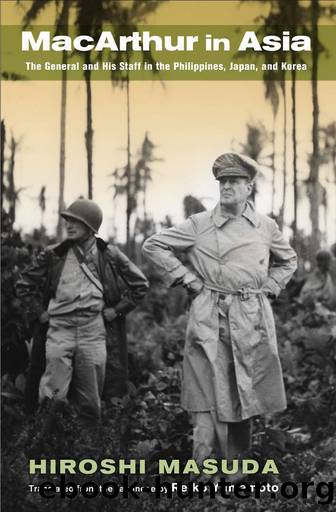MacArthur in Asia by Hiroshi Masuda Reiko Yamamoto

Author:Hiroshi Masuda, Reiko Yamamoto [Hiroshi Masuda, Reiko Yamamoto]
Language: eng
Format: epub
ISBN: 9780801449390
Barnesnoble:
Publisher: Cornell University Press
Published: 2012-11-15T00:00:00+00:00
Conflict with the U.S. Navy Leadership
While the SWPA under MacArthurâs command was turning to the offensive in New Guinea, the POA under Nimitz had in August 1942 won a victory in the Solomon Sea and, launching a successful landing on Guadalcanal in the Solomon Islands, was broadening its deadly combat against the Japanese. In October, the U.S. fleet commanded by Admiral Thomas C. Kinkaid engaged in a fierce battle around Henderson Air Base on Guadalcanal against a vanguard of the Japanese navy led by Vice Admiral Kondo Nobutake and fought against Vice Admiral Nagumo Chuichiâs mobile force in the ocean north of Guadalcanal and Santa Cruz. The Japanese won a tactical victory, sinking the U.S. aircraft carrier Hornet and shooting down seventy-four aircraft, but they suffered a strategic defeat thereafter in the Battle of Midway, losing one hundred aircraft and many well-trained pilots. In November, furthermore, the Japanese suffered a crushing defeat in the third phase of the Battle of the Solomon Sea. In February 1943, they withdrew from Guadalcanal and a battle that had lasted half a year came to an end. As a result, sea and air supremacy shifted from Japan to the United States, and Australia was liberated from any real threat of invasion.
Meanwhile, MacArthur and Admiral Ernest J. King, chief of Naval Operations and commander in chief of the U.S. Navy Fleet, disagreed sharply over the leadership and strategy of the war against Japan. MacArthur believed that operations should be unified under his command and emphasized that the offensive against Japan should consist of the capture of New Guinea and the Philippines followed by an assault on the Japanese main islands. King, on the other hand, argued that the more effective route to the Japanese mainland was to advance north from the Caroline Islands in the central Pacific to the Marianas.
After the end of the Guadalcanal campaign in March 1943, the Joint Chiefs of Staff (JCS) called the chiefs of staff of both MacArthur and Nimitz to a strategy meeting in Washington. However, the two sides simply repeated their assertions and the meeting achieved no more than a confirmation of near-term operation plans. Following this strategy meeting, a U.S.-British summit and a U.S.-British chiefs of staff conference were conducted in Washington in May, but there, too, the conflict between MacArthur and King was a matter of concern. It was feared that the two commanders in charge of prosecuting the war who were split on basic strategy would make future operations impossible. At this point, Roosevelt and Churchill came up with a compromise plan. The advance to Tokyo would be by two routes: the southwestern Pacific route suggested by MacArthur, from New Guinea to the Philippines, Formosa, and Japan, and the central Pacific route favored by King, from the Gilbert Islands to the Marshall Islands, Caroline Islands, Mariana Islands, and then to Japan. MacArthur vigorously opposed the adoption of dual routes, but the decision was not reversed.
Reluctantly, MacArthur ordered an area group consisting mainly of Admiral William F.
Download
This site does not store any files on its server. We only index and link to content provided by other sites. Please contact the content providers to delete copyright contents if any and email us, we'll remove relevant links or contents immediately.
The Sympathizer by Viet Thanh Nguyen(4344)
The Rape of Nanking by Iris Chang(4169)
World without end by Ken Follett(3446)
Ants Among Elephants by Sujatha Gidla(3442)
Blood and Sand by Alex Von Tunzelmann(3167)
Japanese Design by Patricia J. Graham(3139)
The Queen of Nothing by Holly Black(2545)
City of Djinns: a year in Delhi by William Dalrymple(2533)
Foreign Devils on the Silk Road: The Search for the Lost Treasures of Central Asia by Peter Hopkirk(2445)
India's Ancient Past by R.S. Sharma(2433)
Inglorious Empire by Shashi Tharoor(2413)
Tokyo by Rob Goss(2407)
In Order to Live: A North Korean Girl's Journey to Freedom by Yeonmi Park(2361)
Tokyo Geek's Guide: Manga, Anime, Gaming, Cosplay, Toys, Idols & More - The Ultimate Guide to Japan's Otaku Culture by Simone Gianni(2346)
India's biggest cover-up by Dhar Anuj(2336)
The Great Game: On Secret Service in High Asia by Peter Hopkirk(2318)
Goodbye Madame Butterfly(2229)
Batik by Rudolf Smend(2153)
Living Silence in Burma by Christina Fink(2049)
